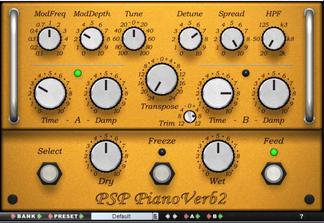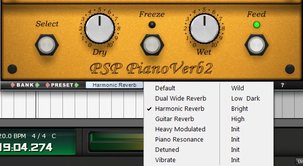PSPaudioware PianoVerb 2 Review
I’ve always really dug reverberation and ambience effects, kids. Even as a teeny bopper, I was always tempted to sing if I was in a (hopefully empty) public restroom, the school gymnasium, an empty community hall, under a highway overpass, and etcetera. If there was a natural ambient space that I could ‘listen’ to, I made noise. I would sing, shout, or clap. I was digging the ‘sound’; ya know? Do you suppose that Eddie Kramer or Mutt Lange ever did the same? I hope so – then I couldn’t be considered a spaz!
One of my absolute favorite types of naturally-occurring ambience is that which happens inside of an old upright-grand piano case. When I was an ankle-biter, I would squirm in behind the old 5ft’ tall, upright grand piano in our living room so I could sing - and make who knows what other awful squawks – ‘into’ the back of the piano. Sometimes I’d stand up on the bench so that I could open the top and yell/sing into it. (some would think I was ‘off-the-noodle’, but I didn’t care . . .)
When I first heard of PSP Audioware’s PianoVerb 2, my attention and interest was immediately all ‘jazzed-up’.
PianoVerb 2 is just too cool, cats. I enjoy and appreciate all of the products that I review, but this one brought a smile, from the very first moment I listened to it. The exquisitely unique character of the reverb effect is incomparable. To my knowledge, there isn’t anything else quite like it. Forget any ‘Lexicon ish’ comparisons here, kids. This groovy little $49 treat is a one-of-a-kind, baby.
Visuals: Measuring 630px wide x 430px high, “Mr. Mustard” sits comfortably on most nearly any DAW’s work screen. I’ve nicknamed PianoVerb 2 as “Mr. Mustard” because of its Dijon Mustard-colored interface. The GUI is as wonderfully unique as its sound. Make no mistake though, gang; “Mr. Mustard” is very cool – not the least bit mean. PianoVerb’s fantabulous retro vibe is complimented by the clear, serif font used for its labels. Thank God, I don’t need the Windows magnifier to read the text; because it’s all ‘right on’, Daddy-O. The controls respond nicely to mouse movements. You won’t get ‘bummed out’ with any uncool, “flakey” GUI controls. The decked-out style of the notched-buttons is ‘far out’, man. The buttons remind this reviewer of those used on a ‘hip’ ’68 SONY Solid State radio. Or better yet, maybe they are better described as having an ‘Abbey Roads Studio’ aura. PSP’s dials are ‘golden’. Tastefully added virtual “rack mount” handles and subtle round-bevelled edges give this ‘delicious’ little pluggie a very nice 3D appearance. I’m digging the tasty offset that the upper portion of this plug-in appears to have; as though the bottom part were a power node built into the “rack”. I can see clearly now – no purple haze! The bright green indicator lights are keen as all get-out. All the buttons and virtual indicator lights are ‘cherry’, ya know; super easy to see at a glance, man. You dig? Overall, PSP have crafted this plug-in to be very unique – inside and out. The interface is definitely jamin’. Foxy, subtle, shadow and lighting is lavished on the edges, “rack handles”, and knobs. Classy. Cool. Ivy-League all the way, baby.
Stereo Imaging and Depth Perception:
Oh yeah, baby! This verb is totally fab at giving the listener a sense of harmonically-rich, dimensional space. The ‘righteous score’, is that this unique, one-of-a-kind, (did I mention unique?) honey-of-a plug-in doesn’t sound like any typical reverb. It’s not a plate, room, hall, or Deep Space 9 type of deal. This one sounds like . . . well . . . like the resonance and shimmering, sonic tickle that you’d hear if you stuck your head into a big ol’ upright-grand piano case. The reverb effects that PianoVerb 2 produces seem to surround the sound source. No, I don’t mean that in a clichéd, over-used, market buzz kind-of-way. Let me lay this on ya, man. Imagine what the encompassing resonances inside of a large upright piano case would sound like; complete with the shimmering quality of 230 metal strings, vibrating across eight octaves, on a brass soundboard. PSP Audioware has given this imaginative scenario a name and some fine C++ substance. It’s called PianoVerb 2. Ok, man, I’m not trying to lay a heavy trip on ya, but please try to expand your imagination even more. Crank the “Time” knob up to 2 O’clock or 3 O’clock and prepare to be mesmerized. Crank it up full-tilt, and prepare to be awe struck. It’s one thing to imagine the natural resonance and reverberations described above, but to experience the effect multiplied by a factor of 5, or even 10, is just about amazing. I can’t describe the sound as cavernous, because that term isn’t really appropriate for this unique type of reverb. However, the effect is deep and immense. Lush, modulated reverbs that can carry on for 10 seconds (maybe longer) are only a turn of a dial away. I suppose if you could create a piano case as large as an Arizona cave, then we ‘could’ call it cavernous . . . . Sound Quality: PianoVerb 2 has such a copious amount of unique charm and character, it has practically invented and defined a new genre of reverberation. I slipped this beauty into the effects chain of a few of my electric guitar and keyboard tracks. “Whoa! What is that?!” I exclaimed to myself. Being the ol' skool kinda guy that I am, I usually go for the best Spring reverb that I can find; until now. Whew! This gee-whiz gadget is a very formidable reverb for guitars. Actually it is most nearly amazing on a sundry assortment of acoustic and electric instruments. I admit it, gang; I have to work hard to cop the creative-writing chops needed to properly convey just how spectacular this reverb sounds. If you wanna be ‘hep’ you had best download the 14-day fully functional demo and find out for yourself. If you’re still hobbling along on some old, subpar piano sample library or limping along with a dilapidated synth VSTi, don’t huck them into the trash bin just yet. Give PianoVerb 2 a tryout first. Prepare to hear your tired, old virtual instruments sound as though they got a new lease on life. If it were possible for an inanimate VSTi synth to be born-again, then PianoVerb 2 is definitely the “Prophet” to herald the message. (Synth . . . . Prophet . . . word association . . . get it?) I’ll be honest with you; I haven’t ventured too far from the factory presets. I don’t feel that I have to – the presets sound so good. I, personally, am one of those home-producers that tends to use factory presets simply as a catalyst to creating so-called “better” and “tweaked” custom settings. Not so with PianoVerb 2. I think the presets are ‘outta sight’! What, with the modulation and resonance transposition controls, there are certainly an abundance of creative boundaries to explore, but for me, the factory presets are keen-o. Potent, harmonically decadent ambience wraps around your aural senses like plush, silky sonic cushions. There is delightful, opulent, chorused modulation at your beck and call. I don’t know what PSP have done to create this lush modulation, but I do know that it is probably THE BEST reverb modulation that I have heard. I’m not making that statement lightly. I’m including my Lexicon LPX bundle, the reverbs I’ve previously reviewed, and the other high quality plug-ins that I own or have demoed. PianoVerb’s modulation is exquisite; delicate, yet abundant. It stands out among its peers. Effects & Features: Across the top of “Mr. Mustard”, excuse me, PianoVerb 2, you see a row of six knobs: ModFreq, ModDepth, Tune, Detune, Spread, and HPF. The ‘ModFreq’ and ‘ModDepth’ accoutrements control the frequency and amount of the reverb’s modulation. The ‘Tune’ knob “tunes” the virtual piano strings 100 cents (+/-). Twiddling the ‘Detune’ knob lets the user ‘detune’ a set of virtual strings to re-create the effect of an improperly tuned instrument. It contributes to the uniqueness of this reverberator. The ‘Spread’ knob . . . . spreads the sound, man. You know, man? Like width, you know? HPF = High pass filter. Knock out those low-end rumbles. Dig?
The second row of knobs: Section A’s ‘Time’ and ‘Damp’. These control the length of the reverb tail/decay and high frequency roll-off, respectively. In the center is the interesting ‘Transpose’ control. With this parameter, you modify the ‘pitch’ of the virtual strings by as much as 24 semitones (one full octave) upward or downward transposition. In conjunction with the modulation controls, a user can create interesting reverb effects befitting the most discriminating audio production projects. The smaller ‘Trim’ knob grants the user fine control over input gain-staging for Section B. “Yeah man, groovy. Hey! Wait a minute, man, what do you mean Section A and Section B?” PSP have kindly given us the nifty “Select” button to instantly switch between two reverb levels. The Tuning and ‘Spread’ parameters are shared between both Sections, but don’t “pooh pooh” this feature as being trivial. Let me present you with a scenario: Let’s say you’re working on the snare track in a slow 100 BPM ballad. Let’s say that the drummer tastefully alternates between sidestick on verses and normal snare hits on the choruses and bridge. The sidestick in the verses needs big, long reverb tails, but the snare hits need to be reeled back in. Customizing each section of PianoVerb 2 for sidestick/snarehits is easily set up; and easily switched between. “Freeze, scumbag!” The muscularly-lean, squint-eyed detective calmly spits out the words through his leather-worn grimace he thinks resembles a smile. The gaunt, wild-eyed ringleader hysterically yells to his trembling cohort, “ C’mon, man! We gotta split! The pigs are here!” “I said, FREEZE scumbag! Wut cha gonna do punk? Go ahead – make my day.” Harry advances with cocky assurance, defiantly challenging opposition. You’re wondering why the brief, out-of-the-blue segue into a classic “Dirty Harry” movie scene; right? It was for no other reason than to creatively introduce the word, “Freeze”. PianoVerb’s ‘Freeze’ function is just that – a freeze. While it is activated, the ‘Time’ and ‘Damping’ parameters remain at the settings they were when ‘Freeze’ was engaged. They can not be altered again until freeze is disengaged. See? The ‘Freeze’ definition was boring. The movie blurb was at least a little bit entertaining. *Reviewer sticks head in top of upright-grand case and sings* 
A convenient, built-in preset tool-bar is inconspicuously arranged at the bottom of the GUI. A broad selection of 12 distinctly different presets is included. Of course, the user is free to create as many custom user-presets as desired.
CPU Consumption:
The plug-in, like most nearly all PSP’s wares, is very light on system resources. It’s immediately responsive and lends itself to insert chains with great ease. Concluding Remarks: PSP Audioware is not a commercial audio-software company, in the ranks of Native-Instruments, WAVES, and others, but their products are absolutely top-drawer. If you, or someone you know, are a fledgling or budget-constrained home-producer, in need of high-caliber reverb plug-ins, then I strongly encourage you to preview and demo PSP’s reverbs. EasyVerb and the unique PianoVerb 2 are not exactly inexpensive, but they can certainly be considered affordable for the degree of quality that they provide. Honorable Menton: Mr. Antoni Ozynski, the driving force behind PSP Audioware, has been the perfect European gentleman throughout the course of time that I have interacted with him. His graciousness, patience and support of Reviewer's Revival is positive and encouraging. As I interact with developers, I not only pay attention to the products; I look for professionalism and a good, honorable business model from the developers themselves. Mr. Ozynski and PSP have high marks in my books. 5 STARS!
Brother Charles is a freelance writer, Gospel music artist and minister. Charles had been a professional touring musician during the nineties; working primarily as a lead guitarist in the Canadian country music industry. Brother Charles is also involved with music production and quality home recording.
3 Comments
Stephanie D. Wiley
5/21/2013 05:16:30 pm
Indeed, I really loved listening a person playing piano because the piano sound makes me relax. But the information given here is I do not know in piano. This is very great for me because it gains my knowledge when it comes to PSP PianoVerb. Thank you!.
Reply
Brother Charles
5/21/2013 05:17:03 pm
Thanks a million, Stephanie. I really appreciate the encouragement and yes, PianoVerb 2 is an amazing plug-in. In the not-too-distant future, I will be reviewing PSP 42 & 85. I hope you can keep an eye out for those as well. :)
Reply
christopher bright
5/1/2024 08:04:13 pm
hi! i just wanted to say thanks for your review of psp's piano verb 2. i've had my eye on it since it's introduction and was surfing the net tonight to try and find some reviews when i came across yours.
Reply
Your comment will be posted after it is approved.
Leave a Reply. |
NO SPAM! IK Multimedia Group Buy
FX Pick & Mix Group Buy - up to 16 for the price of 1
Will You Help?Web hosting is getting more and more expensive all the time, and Reviewer's Revival is NOT funded nor supported by any commercial enterprise or business. A donation of any amount is greatly appreciated. Even $2 or $3 for a coffee - every little bit helps. Thanks very much.
Legal BlurbAll of the articles published on Reviewer's Revival are undertaken to be purely objective, impartial reviews. Reviewer's Revival is not owned, funded-by, nor hired by any company or individual. Reviewer's Revival is the sole property of, and solely under the discretion and direction of Brother Charles. |





 15% OFF Summer Sale!
15% OFF Summer Sale!
 RSS Feed
RSS Feed

